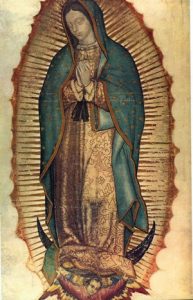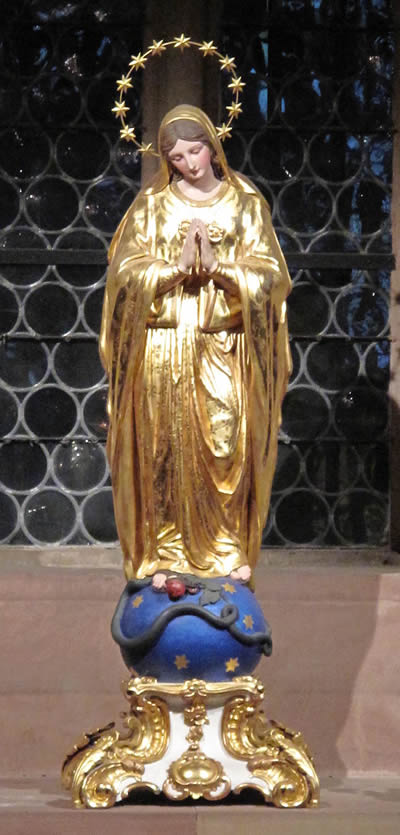When You Watch the Eclipse, Think of How God Came to Earth
It just occurred to me — last week — that solar eclipses are a symbol of the Incarnation.
Let me explain.
They Shall be as Signs
Heavenly objects don’t influence our fates as astrologers believe. But Genesis 1 tells us that they can be “signs” to us of what God is doing. And in Scripture they often do just that. Think of the star that guided the Magi to Bethlehem to celebrate the birth of the King of Kings.
The Lady and the Dragon
Since the first century, Christians have associated Mary with the Moon. It started in the book of Revelation. In that last book of the Bible, God gives John a great vision, probably while the Apostle gazed up at the night sky on the Island of Patmos.
In Chapter 12, John says:

Our Lady of Guadalupe
And a great portent appeared in heaven, a woman clothed with the sun, with the moon under her feet, and on her head a crown of twelve stars; she was with child and she cried out in her pangs of birth, in anguish for delivery. And another portent appeared in heaven; behold, a great red dragon, with seven heads and ten horns, and seven diadems upon his heads. … And the dragon stood before the woman who was about to bear a child, that he might devour her child when she brought it forth; she brought forth a male child … (Revelation 12: 1-5)
The text goes on like this, moving between time and eternity, piling symbols upon symbols. Rarely do they refer to just one thing. But it’s not a stretch see this text as (at least in part) a reference to Mary, the mother of Jesus.
The Moon at Her Feet
That’s why so many famous images of Mary show her standing on the Moon. In the famous image of Our Lady of Guadalupe in Mexico, Mary wears a starry robe, surrounded by sunlight, and stands on top of a crescent moon.
Others, such as the statue in the Strasbourg Cathedral, show Mary with a ring of stars around her head, the sphere of the Moon at her feet, and a serpent crushed under her foot. This is inspired not only by Revelation 12, but by Genesis 3:15. There, God predicts that the head of the serpent (Satan) will be crushed by the seed of a woman. Mary is that woman. Jesus is that seed.

Virgin Mary in Strasbourg Cathedral
Images of Mary with baby Jesus abound in Christian art. But most images inspired by Revelation 12 do not show Jesus. That’s because they’re images of Mary when she’s pregnant.
Pointing and Hiding
When Mary first enters the biblical story, she’s just a young virgin from backwater Nazareth. Yet the angel Gabriel comes to her. He announces that she has found favor with God, and that she will conceive in her womb a child, who shall be named Jesus. Jesus will be the very Son of God. (Luke 1: 26-38)
During Jesus’ ministry, Mary never draws attention to herself. She points others to her Son. When she comes on stage early in John’s gospel, she’s telling servants at the wedding feast in Cana, “Do whatever he tells you.” And when her Son dies on Calvary, she is mourning at the foot of His Cross.

The Annunciation, Fra Angelico
When she’s pregnant, though, Jesus is hidden within her body. No one can see Him. Think of it. The God of the universe, was, for a moment, small, hidden from view, inside the womb of one blessed young woman.
Something Inside That’s Bigger Than the Whole World
C.S. Lewis alludes to this mystery in the final novel of his Narnia series, The Last Battle. In the climax, the good guys, including Tirian King of Narnia, Queen Lucy, and Lord Digory, are besieged by their enemies. They’re forced into a small stable, where they expect to encounter the demonic Tash. Instead, they see another world.
Tirian looked round again and could hardly believe his eyes. There was the blue sky overhead, and grassy country spreading as far as he could see in every direction, and his new friends all round him laughing.
“It seems, then,” said Tirian, smiling himself, “that the stable seen from within and the stable seen from without are two different places.”
“Yes,” said the Lord Digory. “Its inside is bigger than its outside.”
“Yes,” said Queen Lucy. “In our world too, a stable once had something inside it that was bigger than our whole world.”
Not just a stable. A woman, too, had inside her body the Creator of the whole world.
The Moon Hides the Sun
Now think of a total solar eclipse. A celestial body hides a bright star that is 400 times larger than it is. That body emits no light of its own, though it reflects well the light of the Sun.
One humble woman enclosed and for a moment hid God Himself.
It’s like the first moments of the incarnation. One humble woman hid God Himself. God chose to come to us, not first as a grown man, but through conception in the womb of a woman, where He developed, as we all do, inside His mother’s body.
Of course, even then, He did not disappear. And during an eclipse, the Sun still shines brightly. If you are in the Moon’s central shadow, though, you cannot see the Sun.
And so, on August 21, when you watch the Moon cover, for just a moment, the bright photosphere of the Sun, remember this. God came to us, hidden for a moment, in and through one young woman who, when asked by God to play a part in the cosmic drama of salvation, said simply: “Let it be done to me according to your will.”

Jay Richards is the Executive Editor of The Stream and co-author of The Privileged Planet. Follow him on Twitter.







